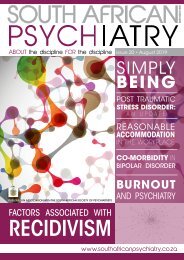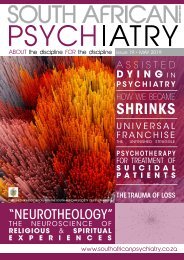South African Psychiatry - November 2018
South African Psychiatry - November 2018
South African Psychiatry - November 2018
You also want an ePaper? Increase the reach of your titles
YUMPU automatically turns print PDFs into web optimized ePapers that Google loves.
ORIGINAL<br />
AS EACH PROGRAMME DEVELOPED IN<br />
COHESION AND COMPLEXITY, THE ABILITY<br />
OF THE MEMBERS TO DEMONSTRATE<br />
LEADERSHIP AND TEAMWORK, AND TO<br />
EXERCISE ABSTRACT THINKING AND<br />
PROBLEM-SOLVING SKILLS, WAS TESTED<br />
AND ENCOURAGED.<br />
During the exercise in which participants had to<br />
lead a horse into an enclosed rectangular space<br />
on the ground, without touching it or leading it<br />
with a halter or lead-rope, various solutions were<br />
attempted. These included coaxing the horse with<br />
handfuls of grass, and forming a human ‘tunnel’,<br />
with raised hands, through which the horse was<br />
encouraged to walk. In another exercise, a patient<br />
successfully kept the horse, which was moving<br />
slightly, within an enclosed space by moving the<br />
boundary, instead of attempting to keep the horse<br />
still, thereby demonstrating an interesting and<br />
creative use of problem-solving abilities. Participants<br />
who attempted to physically drag or push horses into<br />
spaces or along paths quickly realised that this was<br />
a mostly unsuccessful strategy, as reflected back to<br />
them by the horse’s unwillingness to move.<br />
WHEN THE EXERCISES PROVED<br />
CHALLENGING AND PARTICIPANTS<br />
WERE UNSUCCESSFUL IN ACHIEVING<br />
THEM, FRUSTRATION AND GROUP<br />
FRAGMENTATION OFTEN FOLLOWED.<br />
WHEN THIS OCCURRED, OR WHEN<br />
IT HAPPENED SPONTANEOUSLY, THE<br />
HORSES REFLECTED THIS BY BECOMING<br />
‘SKITTISH’ AND DIFFICULT TO WORK WITH.<br />
The groups were increasingly aware of this, and<br />
realised that calm cooperation often resulted<br />
in better outcomes. In general, the participants<br />
became more attuned to the characters and needs<br />
of the horses, and this was evidenced by more<br />
attentive and careful grooming as the programmes<br />
progressed, and by approaching horses differently<br />
– for example, during one session a particularly<br />
engaged and aware patient learned that<br />
approaching a temperamental horse from the side,<br />
rather than the front, led to a better engagement<br />
with that horse. In addition, one particular patient,<br />
who in the first sessions consistently behaved in a<br />
provocative manner towards the horses, by slapping<br />
them on their hind-quarters, was able to receive<br />
a clear message from them that this was not<br />
acceptable and was able to change his behaviour<br />
accordingly.<br />
Metaphors were introduced into the sessions early on<br />
and depending on the make-up of the groups were<br />
comprehended and worked with by the participants<br />
at various times within the programmes. Examples of<br />
these included:<br />
• What do the horses remind you of?<br />
• If you approach people differently would<br />
they react differently, in the same way that<br />
the horses do?<br />
• When you are feeling frustrated by not being<br />
able to achieve something, how do you<br />
cope?<br />
• How does one know when a horse/person<br />
is calm?<br />
• What does it feel like to have a handicap?<br />
• The male and female horses continue to<br />
keep separate from each other – does this<br />
reflect what happens in your life?<br />
• What does it feel like to have a reliable horse<br />
around?<br />
• Can you think of a situation in your life where<br />
you might need ‘lead-ropes’ and someone<br />
to give you direction?<br />
An example of a metaphor being successfully and<br />
spontaneously grasped and understood occurred<br />
towards the end of a programme, when the group<br />
took down an obstacle that the horse was not<br />
walking over and used the materials instead to create<br />
a path which the horse successfully negotiated. As<br />
well as providing metaphorical material which they<br />
were able to engage with and discuss, none of<br />
the rules which had been set for the exercise were<br />
contravened; the outcome was therefore also a<br />
success in terms of the group’s problem-solving skills,<br />
and it provided them with a sense of empowerment.<br />
As a further example, during two of the exercises<br />
each participant was requested to write down goals,<br />
values, and something they needed to protect in<br />
their lives. The lists were then used in exercises with<br />
the horses. The participants could identify that the<br />
horses were being supportive during the exercises<br />
and were able to link this to the need for support<br />
systems in their own lives.<br />
The participants themselves tended to form subgroups<br />
and alliances that endured throughout the sessions.<br />
There were also consistent and interesting pairings<br />
of dominant and quiet members within the groups.<br />
Generally, the participants of each programme got<br />
along well, and were willing to help each other. There<br />
were no displays of hostility or aggression towards<br />
each other, nor towards the facilitators.<br />
The selection process for each programme was done<br />
by the occupational therapists and psychiatrists<br />
working in the unit. Overt psychosis was an exclusion<br />
criterion. Generally, in each successive year, as The<br />
Equinox Trust and Valkenberg teams gained more<br />
experience with working with EAP in a psychiatric<br />
population, higher functioning patients tended<br />
to be selected for each group. This resulted in the<br />
participants working more rapidly with metaphors,<br />
which appeared to lead to greater cohesion and<br />
support within the groups.<br />
For the <strong>2018</strong> group, participants were primarily<br />
selected on the basis of challenging behaviours,<br />
including intrusiveness, physical and verbal<br />
aggression and hostility, as the literature currently<br />
SOUTH AFRICAN PSYCHIATRY ISSUE 17 <strong>2018</strong> * 13

















